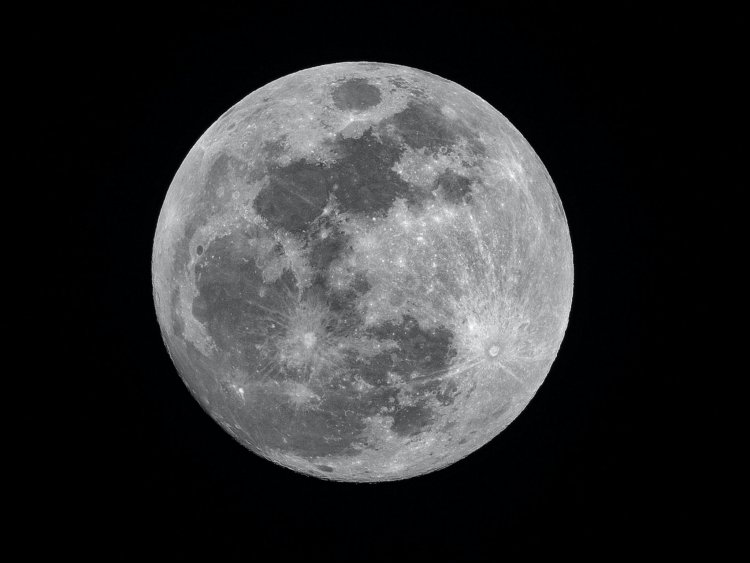The eternal satellite, the white-gray disk, or the changing sickle that rolls out into the night sky. It may seem that there is nothing new left. But the moon holds many secrets and new possibilities. They are waiting to be discovered and we will tell you about them.
Where did the Moon come from?
There are two main versions of the Moon origin.
The first one – the megaimpact hypothesis – states that it occurred as a result of a collision between the Earth and a Mars-sized body, conventionally called Theia. Due to the “impact,” the upper shells of the Earth moved into a near-Earth orbit. And then they formed a satellite. The Moon’s chemical and mineral composition is identical to the Earth’s crust. It has few metals, and the volatile compounds that make up Theia have most likely evaporated. By the way, the Moon also has water. It is located near the poles in a bound state. Perhaps, it got there during the fall of asteroids and comet nuclei.
There is a second version of the Moon’s “birth,” which states that both celestial bodies have emerged from different parts of a subplanetary disk almost simultaneously. The Earth was formed from its central part, while the Moon – from the outer ring.
This assumption interprets many features that cannot be explained with the first version more successfully. In particular, we are talking about the ratio of isotopes.
But this raises the question: why the axis of the Earth rotation is tilted by 23 degrees? Most likely, the reason for this is an external influence. If it were not, its axis of rotation would be perpendicular to the plane of the orbit.
That’s why
One of the Moon’s greatest advantages is the conditions constancy. At a depth of only two meters below its surface, the temperature is stable to within one degree. With this protection of the lunar soil, cosmic radiation is not dangerous – it remains at a minimal level. And if we create rooms with an artificial atmosphere under this lunar soil, we won’t have to fear natural disasters.
The moon is composed of the hardest basalts. Scientists note that this material is quite suitable for the construction of multistory buildings without additional fixings. According to them, the “lunar” size is suitable for the construction of apartment buildings for billions of inhabitants, who can be provided with food produced locally.
Alexander Bagrov and Vladislav Leonov in their work Problems of Transition from Moon Exploration to Its Development tell that there are enough resources on the Moon to provide local industry, and due to constant conditions, the erected buildings may stand without repair for millions of years. On Earth, in turn, buildings need to be renewed every 50 years.
Scientists call the Moon an “ark” that will help survive various cataclysms. But in order to do so, it is necessary to develop it.
Research
When did the first explorations of the Moon begin? It happened more than 2,200 years ago – scientists made mathematical calculations and could conduct only visual observations. For example, in the 3rd century BC, Aristarchus of Samos calculated the distance to the moon and its diameter.
As for observations, in 1610, Galileo Galilei, first recorded the mountains and craters on the moon using his telescope. It formed the basis for the detailed surface maps of the visible side of the Moon.
The lunar disk has been an object of interest to scientists for the entire history of mankind. Sergey Krichevsky distinguishes the following periods:
The first period (until the end of the fifties of the 20th century). This time is characterized by visual and instrumental observations of the Moon from the Earth: first from its surface and later from aircraft in the atmosphere. The first ideas, concepts, and theories begin to emerge. Specialists make calculations, measurements and estimates related to the origin, evolution, and properties of the Moon.
The second period (since the late 1950s). The use of unmanned and manned spacecraft begins. It has become possible for people to participate in the near-lunar space and on the Moon, too.
The 1960s and 1970s are famous for the first “lunar race” between the USSR and the USA. The two powers were competing for the first place in the satellite exploration.
At that time Russia created projects for lunar exploration that included lunar bases and settlements. Many of them never became a reality (e.g., the large project titled “Barmingrad”).
The upcoming third period of the space age – 10s of the 21st century – the new, second world “lunar race.” Its main goal is the “second coming” of man to the Moon and its development to create a supplement to humanity’s terrestrial economy. Many countries around the world are creating unique projects, space missions and launches. This is the future that is already happening.
Something that is going to happen soon
Russia recently adopted the Federal Space Program of Russia for 2016 – 2025. And this is the beginning of a new space era.
The Luna-25 mission is scheduled for 2021. It has two purposes – to master soft landing techniques in the mountainous terrain near the south pole of the Moon and to solve some navigation tasks. Russian scientists plan to use a small set of scientific instruments to study the physical properties of the lunar regolith and its mineralogical composition.
The next global Russian mission, Luna-26, will take place in 2024. Its global objectives are to study hard space radiation and the Moon from a polar orbit. The Moon surface will be mapped.
A year later, in 2025, the Luna-27 heavy vehicle will land at the bottom of a crater near the Moon’s south pole. Scientists will study the composition of lunar rocks at a depth of two meters. They have prepared a special cryogenic drilling rig for this purpose. It will help extract the water ice. Its search will continue with the Luna-28 Grunt mission (2027). In 1976, a successful delivery was carried out by the Luna-24 mission. At that time, these samples were extracted from a depth of 2.5 meters. And this time ice cores will be delivered to the Earth from a drilled well in a frozen state.
This will not be the end of lunar exploration. The next stage is to set up a visiting base on the Moon. It will happen gradually.
The first phase, the “Sortie,” will take place in 2021-2025. During this time, scientists will develop and test Eagle, an advanced manned spacecraft. Besides, they will launch an orbital station into a near-lunar orbit.
During the second stage – “Forpost” (2025 – 2035) – the manned flights over the Moon will be carried out and the first modules of the visited base will be delivered to its surface.
After 2035, the third stage – “Base” – will begin. A full-fledged visiting base will be deployed and industrial extraction and processing of lunar ice as raw material for oxygen-hydrogen jet engines will begin.
Photo on the homepage and on the page: Mike Petrucci / Фотобанк Unsplash






















